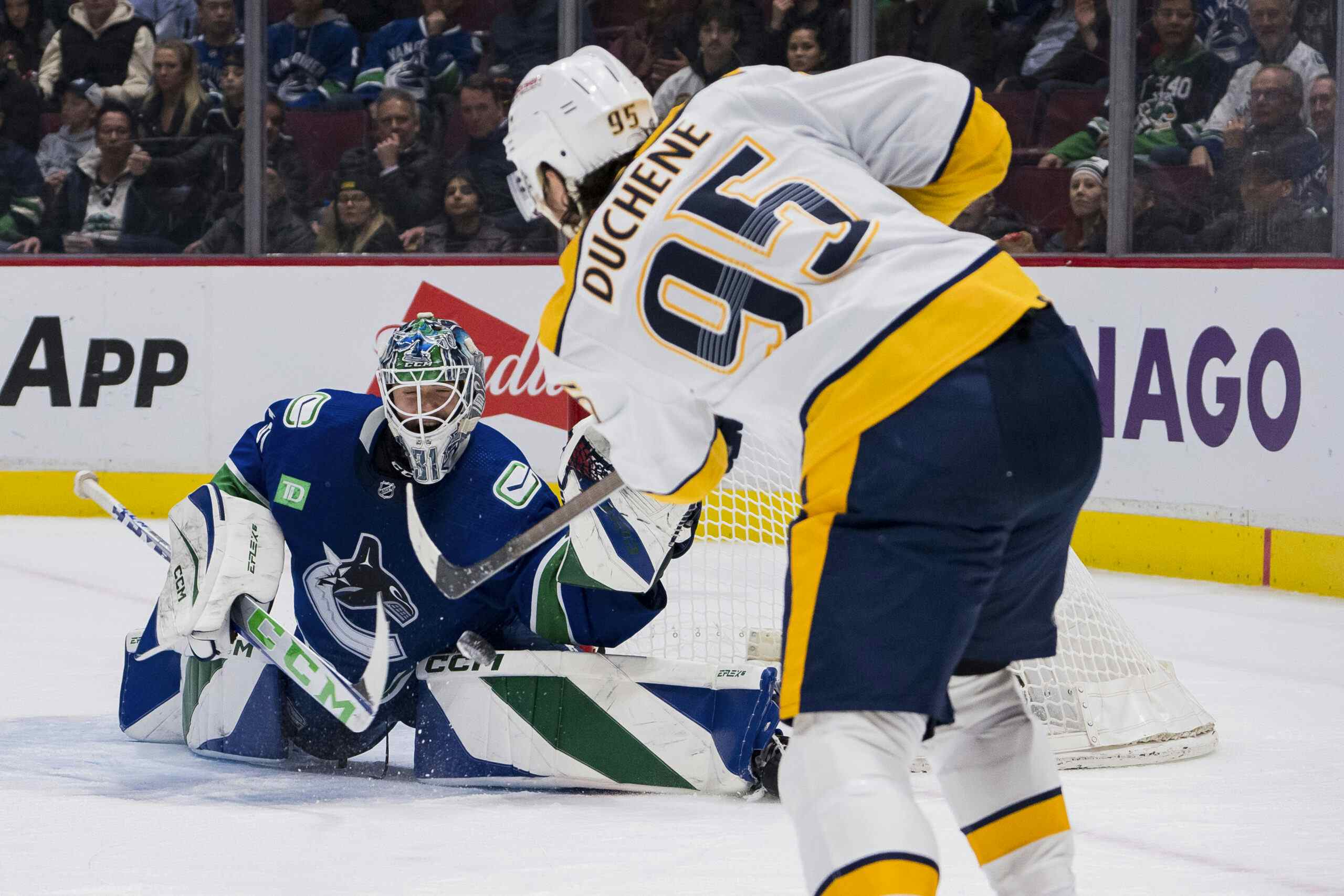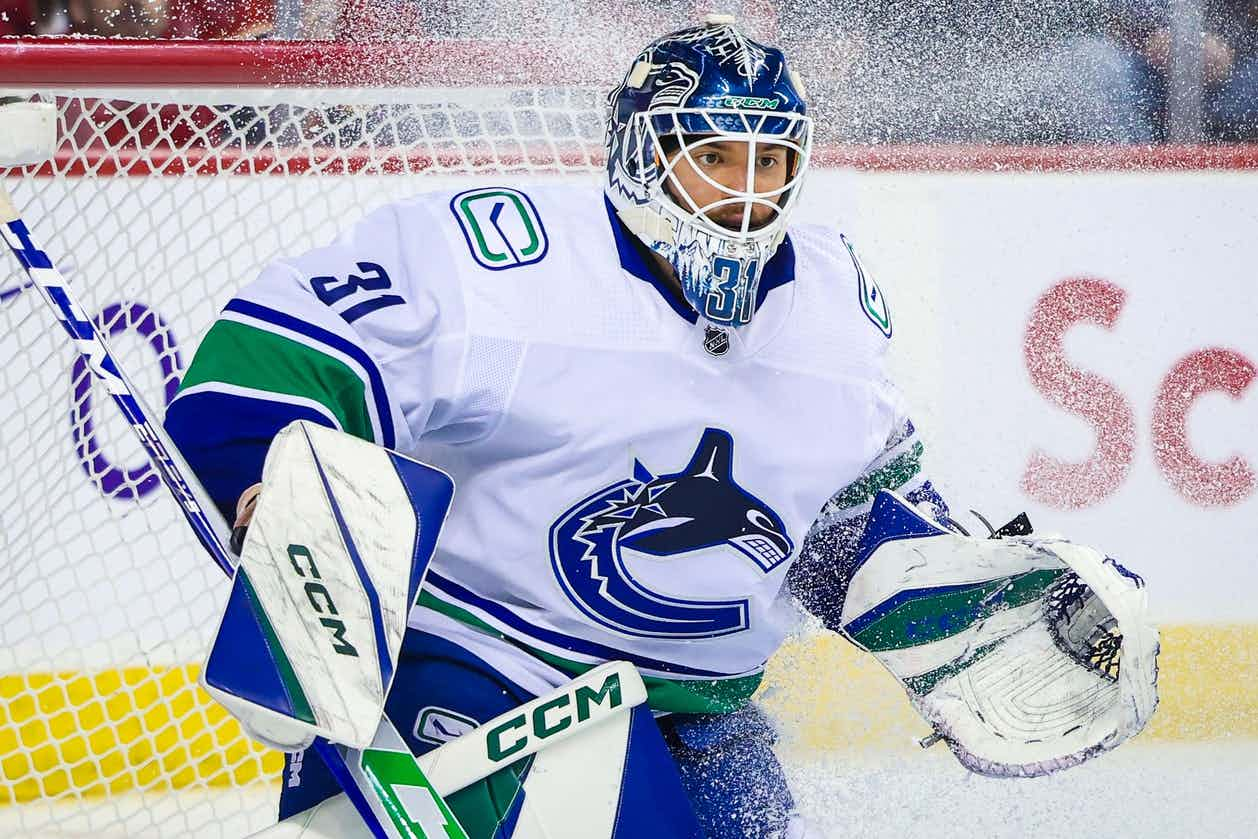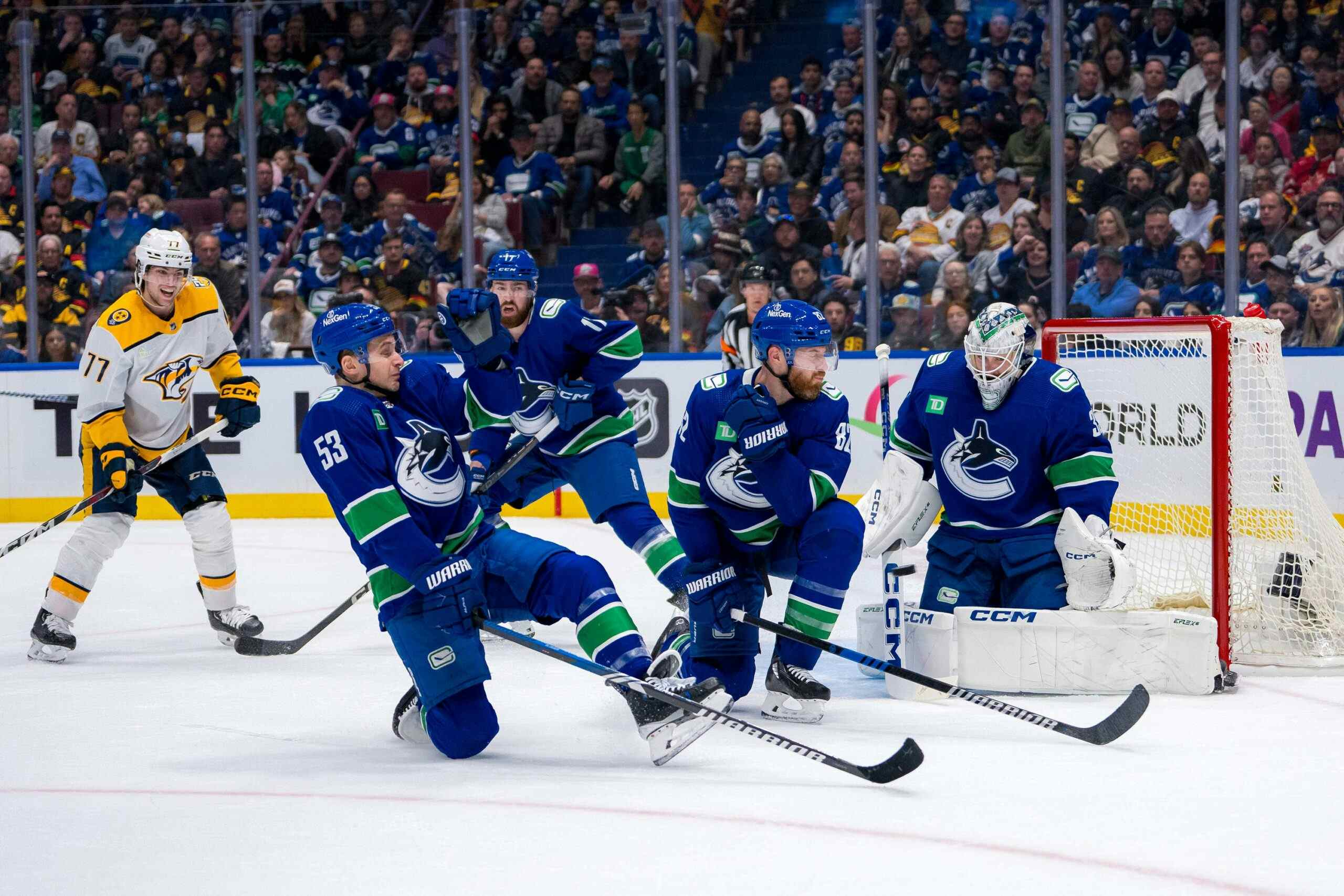How Could the Canucks Use Their 4 Post-Deadline Call Ups?
By Jeremy Davis
7 years agoThe NHL
trade deadline isn’t just a time for blockbuster trades, it’s also a time for
paperwork!
trade deadline isn’t just a time for blockbuster trades, it’s also a time for
paperwork!
Wait,
come back! This will be about Canucks prospects and stuff.
come back! This will be about Canucks prospects and stuff.
The CBA
constrains NHL teams to just four minor league call ups following the trade
deadline (emergency call ups notwithstanding). Sometimes these are used on
players that are “papered down”, and other times they are used to
give guys in the AHL a look in the big leagues. The Canucks have options
either, so let’s dig through what those might be.
constrains NHL teams to just four minor league call ups following the trade
deadline (emergency call ups notwithstanding). Sometimes these are used on
players that are “papered down”, and other times they are used to
give guys in the AHL a look in the big leagues. The Canucks have options
either, so let’s dig through what those might be.
CBA Rules
As is usually the case, transfers to and from the minors must be made within the confines of the rules of the NHL’s Collective Bargaining Agreement.
A little bit of translation to start: The CBA doesn’t typically refer to the trade deadline as “the trade deadline”, instead preferring to use the fancier (and technically correct) term “3:00 p.m. New York time of the fortieth (40th) day immediately preceding the final day of the Regular Season.” Shocking that TSN and Sportsnet have chosen to market the phrase Trade Deadline Day instead of that mouthful.
The majority of the rules governing the transfer of players to and from the minor leagues are covered in Article 13.12, which includes subsections spanning from (a) to (n). Provisions relevant to the Trade Deadline begin at subsection (j), which states that no players may be loaned to the minors (meaning the American Hockey League) outside of the following three conditions: the player was recalled following the deadline, the player was on the Bona Fide Long Term Injury/Illness Exception (LTIR), or the player was disabled at the time of the deadline and has been on the roster for less than 25% of the period dating back to the beginning of the regular season.
Subsection (k) exists only to inform us that recall from an affiliated league may only occur subject to the provisions of subsections (l), (m), and (n), which cover post-deadline recalls, emergency recalls, and post-season recalls respectively.
For the purposes of our discussions relevant to the Vancouver Canucks, subsections (l) and (m) are the most pertinent, since the Canucks will have no need for post-season recalls this year.
Article 13.12 subsection (l) lays out the limits to player recalls following the Trade Deadline:

Simply stated, teams are allowed to make up to a maximum of four standard recalls following the Trade Deadline (with exceptions being the other two subsections in this group: emergency recalls, and after the completion of the regular season). That means that they have to be very careful about who they call up and when. There are a couple of different major reasons for using these recalls for teams in the Canucks’ position: “papering down” players, and “giving someone a look”.
Papering Down
“Papering down” a player refers to loaning them to the team’s minor league affiliate strictly for the purposes of them being on the roster at the time of the Trade Deadline, before calling them immediately back up following the deadline.
The purpose of this is to allow for the possibility of that player joining the minor league team later in the year and possibly for the playoffs. This would otherwise be restricted by Article 13.12 (j), referred to above, as well as the AHL rule that states that players must be present on the roster of an American League club at 3:00 p.m. Eastern time on the day of the NHL Trade Deadline in order to be eligible to participate in the Calder Cup playoffs (with the exception of players from other leagues willing to sign PTO’s and ATO’s following the completion of their own seasons).
In 2015-16, the Canucks took full advantage of this, assigning Jacob Markstrom, Adam Clendening, Ronalds Kenins, and Alex Biega to the AHL on Deadline day before immediately calling them back up, using three post-deadline recalls in one fell swoop (Markstrom was an emergency recall in place of the ailing Ryan Miller), before using the fourth on Frank Corrado just a few days later.
Last season presented a very odd case for the Canucks. They already had Chris Higgins and Brandon Prust playing in the AHL, and Yannick Weber had just recently cleared waivers. The Canucks had three options on their roster to paper down if they chose to do so (Bo Horvat, Ben Hutton, and Markus Granlund), but instead decided against it. Jake Virtanen and Jared McCann, meanwhile, were ineligible to get to the AHL roster in the first place, unless they were assigned to their junior teams before the deadline. They had waived Adam Cracknell the weekend prior with the intention of papering him down, but he instead was claimed by the Edmonton Oilers.
This season, the Canucks again have an unusual situation on their hands, this time due to the mumps catastrophe.
Prior to the mumps reinforcements, the only waiver exempt players on the team were Brendan Gaunce, Troy Stecher, and Nikita Tryamkin. We already know that Tryamkin has no interest in playing in the AHL, so papering him down would be a complete waste of a recall. Gaunce and Stecher are interesting cases. Both have played for the Comets this season (Stecher started the season there, playing four games, and hasn’t been back since; Gaunce played three games on a week long stint about a month ago), but it’s hard to predict what the Canucks might do with them.
On the one hand, management has often spoke of the benefits of playing playoff hockey, even in the American League, where Gaunce, as well as Sven Baertschi and Jacob Markstrom clearly benefited from the Comets’ 2015 run to the Calder Cup Final.
On the other hand, the Comets neglected to assign Granlund to the AHL, even as a paper transaction, because they viewed him as “an NHL player”. They didn’t give much consideration to making Ben Hutton eligible for the AHL playoffs either – a situation that seems analogous to the one Troy Stecher is in now.
Other options might have included players like Jayson Megna and Michael Chaput, both of whom started the season with the Comets. However, given that their names did not appear on the waiver wire today, they won’t be eligible to be reassigned tomorrow morning, and thus will not be able to appear on Utica’s roster at the time of the Deadline.
The situation has been further complicated by the fact that the Canucks have been stricken by the mumps, and thus have had to call up a slew of Comets. In the last week, they have recalled Alex Grenier, Evan McEneny, Joe LaBate, Jordan Subban, Borna Rendulic and Richard Bachman – the final two were more of a result of the Alex Burrows trade and Jacob Markstrom injury. Only Subban has since been reassigned.
Naturally the Canucks will want all or most of those players on their minor league roster at the deadline, as the Comets are in a playoff chase, and the Canucks are clearly not. Predicting what they’ll do requires us to keep up with the latest updates on the Canucks injury/illness situation, which looks like this:
- Ben Hutton and Markus Granlund never actually had the mumps – they’re cleared to return to play.
- Troy Stecher and Chris Tanev did have the mumps. Stecher is good to return to play, while Tanev is still questionable.
- Michael Chaput also had the mumps, and will be out for the next few days.
- Luca Sbisa, who left Saturday’s games with flu-like symptoms, is also good to return.
- Sven Baertschi (concussion) and Jacob Markstrom (Skills Competition) are close to returning, but still out.
Following tonight’s game against Detroit, the Canucks have roughly 48 hours before facing off against San Jose on Thursday. For the Trade Deadline tomorrow then, I would expect all five players currently on recalls to be reassigned to the AHL. Assuming Tanev is ready for Thursday’s game, the Canucks would need have no need for extra defencemen, meaning the McEneny and Subban would stay put in the AHL. Bachman is an easy candidate for an emergency call up in place of Markstrom.
In the absence of Burrows, and the various injuries at forward, the Canucks will need Grenier, LaBate and Rendulic on the roster to stay at 13 forwards. They could choose to use emergency recalls on two of them (to get their roster to 12 forwards, in accordance with Article 13.12 (m)(ii) ), in place of Baertschi, Chaput, and/or Jack Skille, all of whom are supposedly on relatively short timetables. Keeping a thirteenth forward would require the use of one of their post-deadline recalls. However, with the Burrows trade, and perhaps more trades to come, the Canucks might choose to keep a player like Joe LaBate on the roster for the remainder of the season.
Giving Someone a Look
The other purpose of the four post-deadline recalls, a purpose particularly useful for teams like the Canucks that are already essentially out of the playoff running, is giving an NHL shot to prospects in the American League.
With the Canucks already establishing themselves as Deadline sellers, they may need to make additional recalls in order to fill out their roster come Thursday. The most likely trade fodder they have now is Jannik Hansen and Ryan Miller, a forward and a goaltender who are just as likely as not to still be here on Thursday. With Biega meeting the games played threshold for the expansion draft, it’s not out of the realm of possibility that they could deal Luca Sbisa to a team looking for defensive depth and expansion fodder of their own.
The most obvious forward candidates to take a look at are the three that are already on the roster: Grenier, LaBate and Rendulic. Jake Virtanen is also a possibility, but given his season, he might be better off just remaining in Utica. Cole Cassels, Mike Zalewski, and Michael Carcone are the other three forwards on NHL contracts, but none of them has really done enough to earn an NHL shot at this point. Ironically, the two players probably most deserving of call ups at this point, Curtis Valk and Darren Archibald, are on AHL contracts, and thus not eligible.
On defence, Evan McEneny looks to be a first choice. Jim Benning had nothing but good things to say about him when he was originally called up last weekend, the same going for the Comets coaching staff. Jordan Subban is also an option, though the Canucks have brought him up twice now and have yet to play him. Andrey Pedan is a player that probably should be on the NHL roster already, but unfortunately has spent 30 on one without playing a single game, and now the Canucks can’t bring him back up without worrying about exposing him to waivers again if he needs to return to Utica. The other NHL contracts on defence are Ashton Sautner, Tom Nilsson, and Chad Billins, though again none of them seems particularly deserving of an NHL stint.
Decisions
The Canucks now have to decide how they’re going to balance their NHL and AHL clubs, with an eye to development. My guess is that it’s unlikely that they will paper down any of their waiver exempt rookies, instead keeping the recalls to check out players in their minor league system.
As for the Comets and their potential playoff appearance, they’ll likely just have to deal with the players that were available to them prior to the mumps outbreak, without any discernible reinforcements coming from the big club. Reinforcements might instead come from elsewhere, such as a pair of talented NCAA forwards that could turn pro at the end of the season, or perhaps from the CHL.
Recent articles from Jeremy Davis





